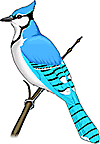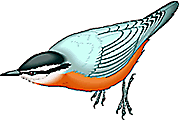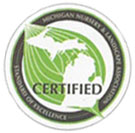Bird feeding 101, Grand Rapids MI
The 3 most important elements for attracting birds:
- Cover Evergreen shrubs and trees provide area to hide and rest.
- Water Yes, birds get thirsty too!
- Food Winter is when a bird’s survival can depend on your feeder.
What’s for supper?
Here are some helpful hints to prepare you for this adventure. First, there are two main types of food that birds will be attracted to in your yard. One is seed and the other is suet (sounds like soo-it). Suet is high quality fat from animals and can be purchased from the meat department of your local grocery store. Many birds that prefer seeds at your feeder also eat seeds in the wild and get them from berries, crops, or other plants. The birds that eat suet, usually find worms or insects in the summer months to fill their stomachs, but can’t find insects in the winter. Some birds also like nuts, fruit, or other table scraps. Look at the list below to find out who eats what.
Birdseed Bonanza:
Grains: Grains are very popular with many bird species. Sunflower
seeds, corn, milo, and millet are common birdfeed grains. Black, oil-type
sunflower seeds and white proso millet are probably the best and most popular
seeds to attract goldfinches, blue jays, cardinals, black-capped chickadees,
evening grosbeaks, pine siskins, purple finches, pine grosbeaks, and
white-breasted nuthatches. Corn is also a very popular grain food on the ear,
shelled, or cracked. Blue jays, house sparrows, starlings, and pheasants all
prefer corn. Milo, another grain, is preferred by
dark-eyed juncos, American goldfinches, pine siskins and tree sparrows.
Cardinals like squash seeds if you’ve got any extras from your fall harvest.
Suet: Suet (beef fat) is a nutritious food for brown creepers, downy
woodpeckers, hairy woodpeckers, red-bellied woodpeckers, red- and white-breasted
nuthatches, and black-capped chickadees.
Thistle: Thistle seed is a great way to attract redpolls, purple finches,
pine siskins, and goldfinches.
Here’s a list of common winter birds and how to attract them with a feeder and
the correct mixture of seeds or food types.
| Bird | Type of Feeders | Type of Food |
| Northern cardinal | ground tray, post, tube feeder | sunflower, safflower, peanuts, cracked corn, white millet, white bread, melon seeds, raisins, bananas |
| Purple finch | high post, hanging and tube feeders | sunflower, safflower, thistle, peanuts, suet mixtures, white and red millet |
| Bluejay | ground, any seed or suet feeders | whole corn, striped sunflower, peanuts, suet mixtures |
| Black-capped chickadee | any type of feeder or the ground | sunflower, safflower, suet mixtures, peanuts, thistle, peanutbutter, pie crust |
| White-breasted nuthatch | all feeders | sunflower, safflower, suet mixtures, peanuts, peanut butter, pumpkin seeds |
| Woodpeckers | suet, hanging log feeders, post feeders | suet and suet mixtures, cracked corn, peanuts, fruit |
| Mourning dove | ground or low tray/post feeders | cracked corn, white and red millet, safflower, thistle, wheat |
Winter feeder care
Don’t just put your feeder out and forget about it. If you provide food in the winter, keep the feeder full since many birds will rely on it as a regular place to eat. Also, it is very important to keep the feeder clean since birds
can get sick from moldy birdseed or pass diseases on from your feeder to another bird. Keep the following tips in mind for a healthy feeding station.
- Give your seed feeders (especially thistle and tube feeders) a shake before you refill them to dislodge compacted seed. Dump out any wet clumps of
old seed. - Clean all hulls off platform feeders and out of seed trays daily.
- Occasionally clean your feeder with a sturdy brush and soap and water
before you refill it. Rinse in a weak bleach/water mix if it looks like you
have any disease problems (please have an adult help you with bleach). Rinse
and allow feeders to dry before refilling with seed. - Wash your hands after filling or cleaning your feeders.
- Don’t allow large amounts of seed to become wet on platform feeders.
Instead, when it’s wet outside, feed birds from covered feeders that will keep
seed dry, or put out only a handful of seed at a time on the platform.Source: dnr.wi.gov










Leave a Reply
You must be logged in to post a comment.